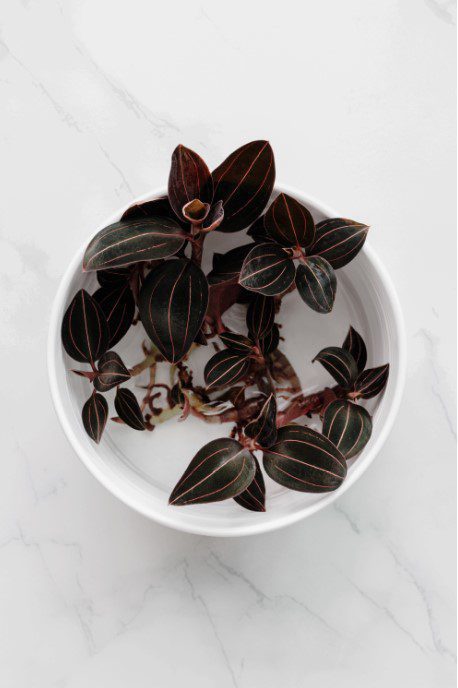Jewel Orchid (Ludisia)

A common belief that all orchids are ordinary flowers suddenly becomes invalid when we talk about Jewel Orchid or Ludisia.
This peculiar orchid variety seems to shatter all the rules: Instead of air it is growing in the soil, unlike other orchids, it prefers shady places and avoids sunny positions.
If they’re so different, then what are jewel orchids? They are one of the simplest orchids a budding grower could own.
If you can grow a begonia indoors, you can be successful with growing jewel orchids.
What Are Jewel Orchids?
They are one of the simplest orchids any grower could own. If you can grow a begonia indoors, you can be successful with growing jewel orchids.
What are Jewel Orchids? Once you search for jewel orchid information, you’ll find several surprising differences.
Jewel orchids are best known for their red and green textured leaves, which have a deep, velvety feeling.
These plants produce white or pale yellow flowers, mainly during the winter or very early spring months.
Ludisia developed on the rain forest floors, so they don’t like a lot of natural light. Too much sunlight can wash out their distinctive leaf colors.
You can grow jewel orchids indoors as a houseplant, and it’s easily propagated by breaking off a piece of rhizome and rooting it in regular African violet soil.
Tips for Growing Jewel Orchids
When you care for Ludisia jewel orchids, forget about everything you’ve learned about growing other orchids.
These are terrestrial, which means they like to have their roots in some form of soil. A commercial African violet mix works perfectly with these plants.
Ludisia orchid care means putting your plants in a spot where they won’t get a lot of temperature fluctuation but will have a good amount of humidity.
Surprisingly, the best room in many houses for this plant is the bathroom.
The steamy air and fluorescent lights are suitable environments to grow the deeply colored leaves without fading while keeping the plant moistened without worrying about extra watering chores.
You may not be worried about producing a massive crop of flowers, but jewel orchids still need feeding.
Give them commercial orchid food according to the package directions, feeding them once a month.
Propagation
Propagate jewel orchids by dividing them, ideally using a sterilized tool to avoid possibly infecting the plant.
Cutaway the pseudobulb and treat it with rooting hormone to increase the chance of propagation, then replant it in warm, moist soil with good drainage.
It’s a good idea to bag up these cuttings to seal in heat and moisture.
Repotting
Repot jewel orchids annually to ensure their soil stays fresh, especially if the plant is beginning to look overcrowded or stressed.
Common signs that an orchid needs to be repotted include falling leaves and roots protruding from the soil’s surface.
To repot, lift the root ball as a whole, replant it in a new container, and then backfill it with soil.
Make sure not to pack too tightly to ensure that the plant is still draining well.
Varieties
Ludisia is a monotype genus and, aside from cultivars, contains only one species.
However, it’s one of many vibrant orchids native to the tropical forests of Southeast Asia, which have the warm and wet conditions necessary to keep a stunning variety of orchids alive.
Ornamental orchids are so prevalent in Singapore, Thailand, and all across the region that the trade in illegal, exotic species has led to the near-destruction of many beautiful varieties.
This, in part, explains Ludisia’s relative rarity.
Grower’s Tips
Like life itself, growing jewel orchids is essentially a matter of balance and moderation.
All factors which contribute to their health must offset each other, and though they do need hot and humid conditions to thrive, they also need good aeration and a little light.
The easiest way to damage these plants is to expose them to too much direct sunlight, so be careful not to burn them.
Keep an eye out for typical orchid pests like scale, which can be dealt with using an excellent eco-friendly fertilizer, and watch for discolorations or falling leaves that can signify that the plant is somehow unhealthy.


























Comments are closed.